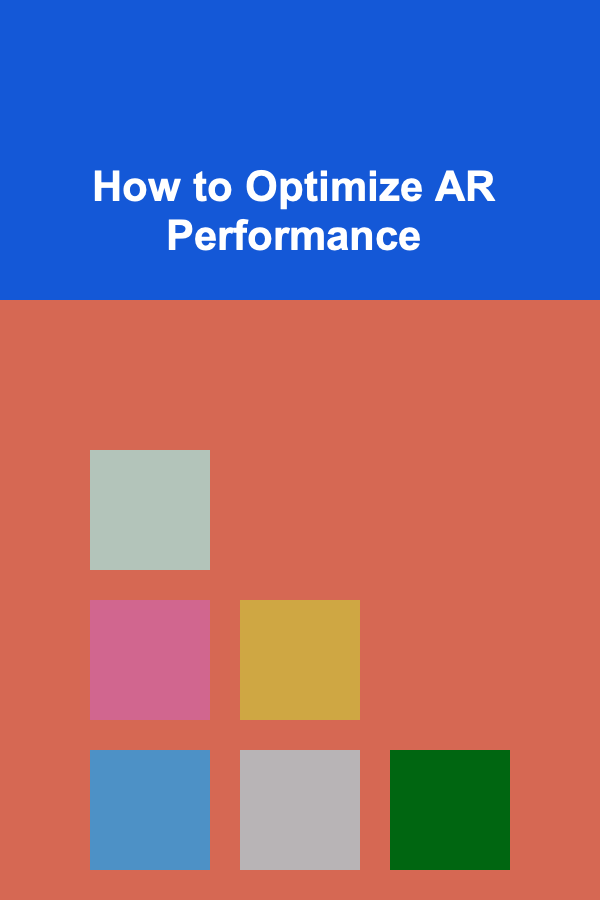
How to Optimize AR Performance
ebook include PDF & Audio bundle (Micro Guide)
$12.99$9.99
Limited Time Offer! Order within the next:

Augmented Reality (AR) is an exciting technology that blends the physical world with digital content. With applications ranging from gaming and entertainment to medical and industrial uses, AR offers immersive experiences that were once the realm of science fiction. However, for developers and businesses looking to create seamless and high-performance AR experiences, optimization is a critical factor.
This article explores various techniques and strategies to optimize AR performance. Whether you are developing AR applications for mobile devices, tablets, smart glasses, or other AR-enabled platforms, understanding how to fine-tune the performance of your AR experience can make all the difference in user satisfaction and application success.
Understanding AR Performance Challenges
Before diving into optimization techniques, it's important to understand the main challenges that impact AR performance:
- Hardware Limitations: AR applications often require significant computing power, especially for real-time rendering, image processing, and spatial tracking. Limited processing power, storage, and battery life of devices can become a bottleneck.
- Rendering Demands: Real-time rendering of 3D objects, video, and animations is computationally intensive. The graphics need to be rendered smoothly to provide an immersive experience. Poor frame rates can lead to lag, jitter, and stutter, which break the illusion of AR.
- Tracking and Spatial Mapping: Effective AR depends heavily on accurate spatial tracking, including recognition of the environment, depth perception, and positioning of virtual objects. Misalignment or tracking loss can result in a disjointed user experience.
- Battery Life: AR applications are often resource-hungry, especially when running on mobile devices. This can quickly drain the battery, which is a major concern for users who want to use AR for extended periods.
- Network Latency: Some AR applications rely on cloud computing or network services for certain functionalities. Slow internet connections or high network latency can significantly impact the responsiveness and overall experience.
Now that we understand the challenges, let's explore the key strategies to optimize AR performance.
1. Optimize Graphics Rendering
Graphics rendering is one of the most demanding aspects of AR applications. To optimize rendering and ensure smooth graphics performance, consider the following:
a. Use Efficient 3D Models
Complex 3D models with high polygon counts can tax the graphics processor. Opt for simpler models with lower polygon counts whenever possible. This reduces the load on the GPU and helps maintain smoother frame rates. Additionally, use LOD (Level of Detail) techniques, where simpler models are used when the object is farther away from the camera and more complex models when it is closer.
b. Leverage Efficient Shaders
Shaders are programs that dictate how objects are rendered on the screen. Optimizing shaders can significantly boost rendering performance. Using simpler shaders and avoiding unnecessary calculations can reduce GPU load. Consider pre-baked lighting effects and textures instead of complex real-time lighting calculations.
c. Apply Culling Techniques
Culling is the process of removing objects that are not visible to the user from the rendering pipeline. This reduces the number of objects the GPU needs to process. Use frustum culling (removing objects outside the camera's view) and occlusion culling (removing objects blocked by other objects) to improve performance.
d. Texture Optimization
Textures can take up a lot of memory, and high-resolution textures can slow down rendering. Use compressed textures where possible, and apply mipmapping techniques to ensure that lower-resolution textures are used when objects are far away from the camera. This will reduce the memory and rendering load.
2. Enhance Spatial Tracking
Accurate tracking and spatial mapping are the foundation of any AR experience. Improving tracking performance is crucial for optimizing AR performance. Here are a few approaches:
a. Use Efficient Tracking Algorithms
Modern AR frameworks (such as ARKit and ARCore) come with built-in tracking algorithms. However, you should still optimize the algorithm usage based on your specific application. For example, if you only need positional tracking, disable more computationally expensive features like full environmental mapping.
b. Leverage SLAM (Simultaneous Localization and Mapping)
SLAM is a key technology for AR, enabling real-time mapping of the environment and the accurate placement of virtual objects. Optimizing SLAM algorithms by reducing the number of features being tracked or using lower-resolution depth maps can enhance performance without sacrificing tracking accuracy.
c. Reduce Tracking Updates
If your AR application doesn't require frequent tracking updates (such as in static or slow-moving environments), consider reducing the frequency of tracking updates. This will free up resources for other tasks and improve overall performance.
d. Use Prebuilt Environment Models
If your AR application works in a predefined environment (such as an office or a store), consider using prebuilt 3D models of the environment. These models can reduce the need for complex spatial mapping and improve tracking accuracy.
3. Optimize Battery Consumption
Since AR applications are often used on mobile devices, conserving battery life is essential. Here are some strategies to optimize battery consumption:
a. Reduce Resource-Intensive Tasks
Avoid running intensive tasks simultaneously. For example, don't render complex 3D objects while performing heavy network operations. Offload non-essential tasks to less busy times to conserve battery.
b. Use Power-efficient Sensors
Sensors like accelerometers, gyroscopes, and cameras play an important role in tracking. Ensure that sensors are used in an optimized way to avoid draining the battery. For instance, use the camera's low-resolution mode when detailed visual data is not required.
c. Apply Dynamic Resolution Scaling
When the system detects that the device's battery is running low, dynamically reduce the graphical fidelity and resolution of the AR content. This can help reduce the GPU load and save battery without sacrificing too much on user experience.
d. Implement Power-saving Modes
Implementing power-saving modes can also optimize battery life. For example, you could dim the display during idle periods, lower the frame rate, or temporarily pause AR content if the device detects that the battery is below a certain threshold.
4. Optimize Network and Cloud Latency
For AR applications that rely on cloud data, minimizing network latency is essential for maintaining a smooth experience. Consider these strategies:
a. Use Edge Computing
Edge computing moves data processing closer to the user, reducing the dependency on distant data centers. By processing data locally or near the user, you can decrease latency and reduce the strain on the network.
b. Preload Content
To reduce network dependency during real-time AR experiences, preload essential content (such as textures, 3D models, and environment maps) before the user engages in the AR experience. This can reduce delays and improve responsiveness.
c. Optimize Data Usage
AR applications can involve significant data usage, especially when transmitting large files. Minimize the amount of data sent over the network by compressing files and reducing the resolution of non-essential data, such as background images.
5. Optimize the Application Code
Optimizing the underlying application code is a crucial part of improving performance. Here are some tips for ensuring your code is optimized:
a. Use Multithreading
AR applications often have tasks that can be run concurrently, such as rendering, tracking, and network communication. By implementing multithreading, you can offload tasks to separate processor cores, making better use of the available hardware and improving overall performance.
b. Profile Your Application
Use performance profiling tools to identify bottlenecks in your AR application. Profiling allows you to pinpoint which parts of your code consume the most resources, enabling you to optimize them for better performance.
c. Optimize Garbage Collection
In languages with automatic memory management (like Java or C#), frequent garbage collection can cause performance spikes. Minimize the frequency of garbage collection by using object pooling and optimizing memory usage to reduce pauses and frame drops.
6. Testing and Continuous Optimization
Performance optimization is an ongoing process. Regular testing is crucial to ensure that your AR application remains efficient across different devices, operating systems, and hardware configurations. Utilize real-world testing and benchmarking to evaluate the performance of your AR application and adjust optimization strategies as needed.
Conclusion
Optimizing AR performance involves a combination of techniques that address various aspects of the user experience, from rendering and tracking to battery consumption and network latency. By focusing on efficient 3D models, optimizing sensors, leveraging SLAM technology, reducing power consumption, and streamlining application code, developers can create AR applications that are both high-performing and energy-efficient.
While AR technology has made tremendous advancements in recent years, there is always room for improvement. By applying these optimization techniques, you can ensure that your AR application provides a smooth, engaging, and seamless experience for users, regardless of the device or environment.

How to Build a Home Budget for a Growing Family
Read More
How to Handle Security Deposits and Avoid Legal Issues
Read More
How to Improve Home Security for Elderly or Vulnerable Family Members
Read More
The Construction Foreman's Toolkit: Best Practices for Safety and Efficiency on the Job Site
Read More
How To Start a Professional Brewery (Small Scale)
Read More
How To Incorporate Collagen-Boosting Products
Read MoreOther Products

How to Build a Home Budget for a Growing Family
Read More
How to Handle Security Deposits and Avoid Legal Issues
Read More
How to Improve Home Security for Elderly or Vulnerable Family Members
Read More
The Construction Foreman's Toolkit: Best Practices for Safety and Efficiency on the Job Site
Read More
How To Start a Professional Brewery (Small Scale)
Read More